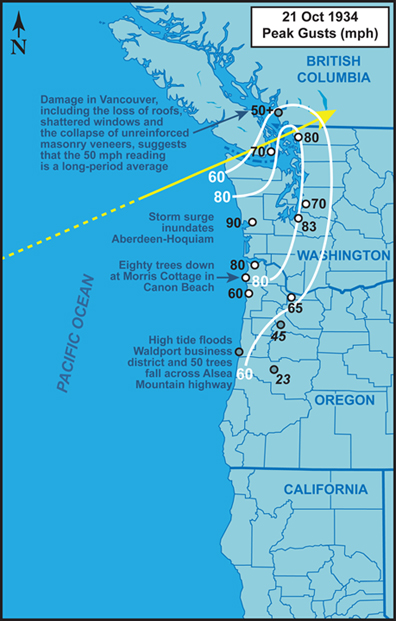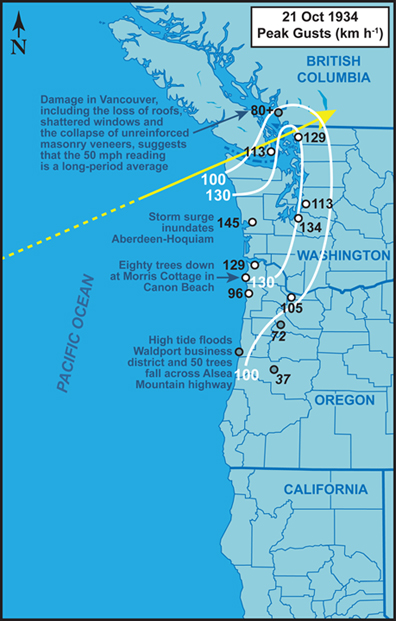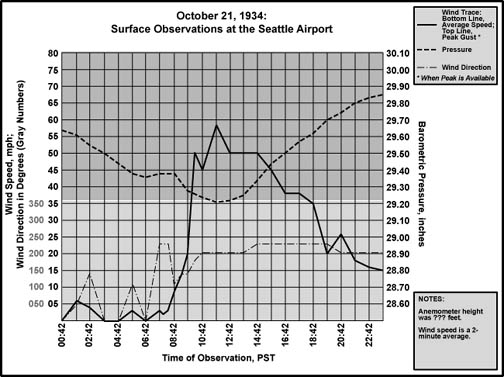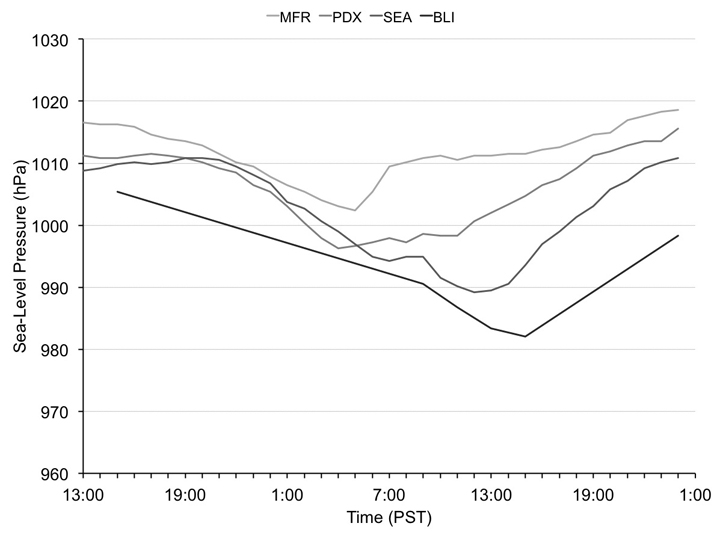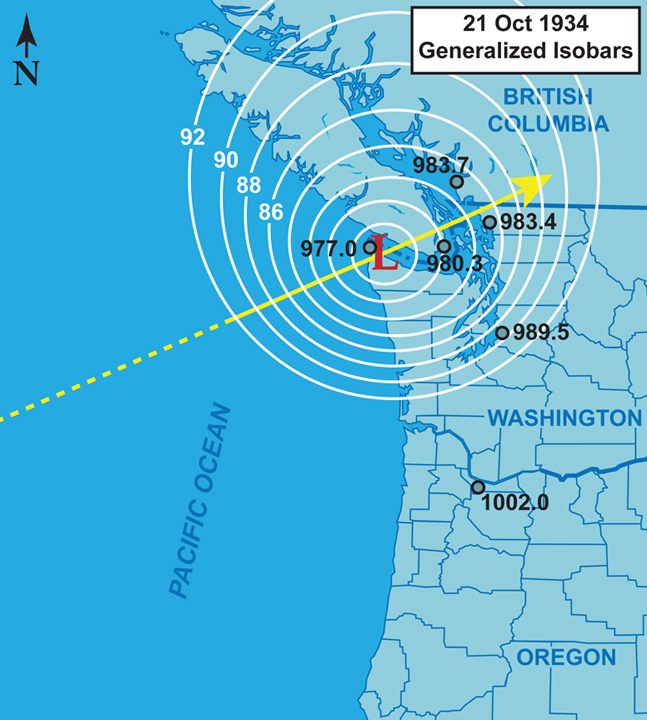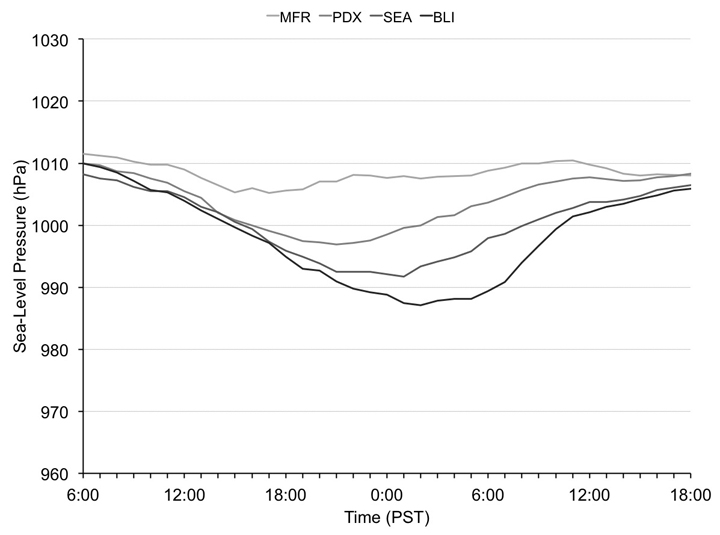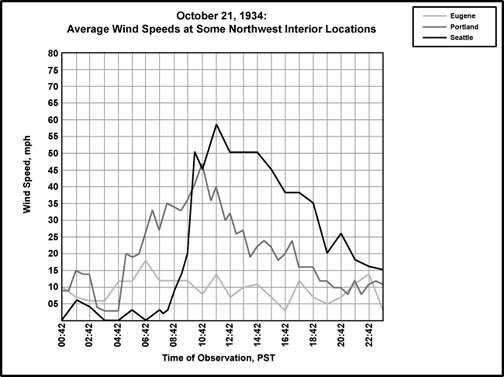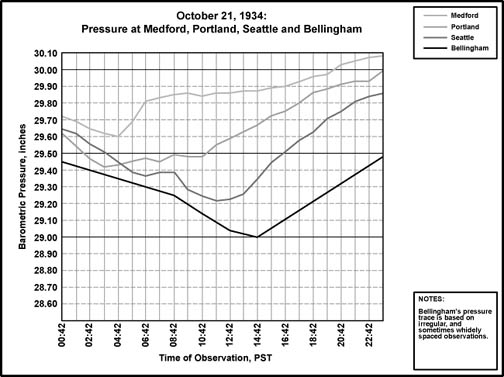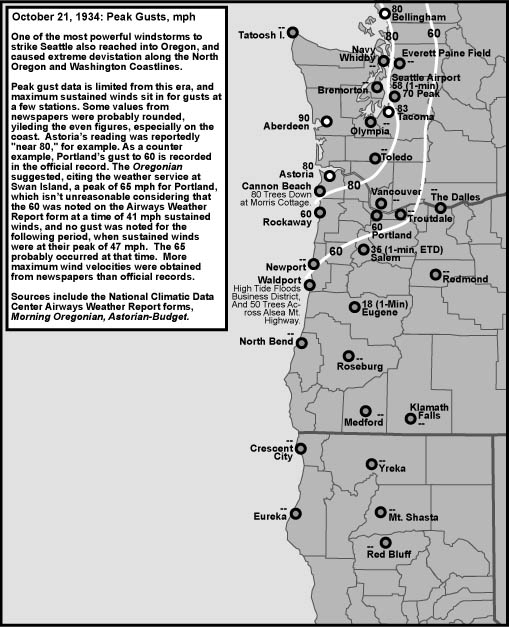The 14:30 observation at Bellingham shows a pressure of 982.0 hPa (29.00" Hg). At the same time, the pressure at Seattle had clearly begun to climb, indicated with a reading of
993.9 hPa (29.35" Hg). This resulted in a major gradient of 11.5 hPa (0.34") between the
two locations. Given the low reading at Bellingham and the
slight change of pressure between 13:00 and 14:30, the center of the extratropical cyclone likely reached
its closest point to Bellingham within the hour 14:00 to 15:00. A barograph trace from Vancouver also supports this, with the pressure beginning a sharp rise just after 15:00 (Vancouver Sun 1934c). The lowest pressure at Bellingham, 982.0 hPa, is probably close to the central pressure of the storm at the time of closest approach, suggesting that the low had weakened by about 7 hPa (0.21") as it tracked from just south of Tatoosh Island to just north of Bellingham. This is a fairly standard filling rate for landfalling storm systems in the Pacific Northwest. Even with this weakening, the low remained a potent wind producer.
By the 14:30 timeframe, average winds at Bellingham had elevated to 75 mph (120 km/h)--Category 1 hurricane speeds--out of the south-southeast,
with squalls to 80, some of the most extreme readings ever recorded in the region.
With these speeds, gusts may have approached 100 mph (160 km/h). The onset of high winds was fairly dramatic. Between the 09:15 and 10:30
readings, wind speeds climbed from south-southwest 3 mph (5 km/h) to south-southeast
20 (32 km/h). Over the next 90 minutes, winds climbed to the average speed of 60 mph (96 km/h) noted earlier.
At the time the pressure started its second, more dramatic fall at the
Seattle Airport, the wind speed jumped with the same drama as witnessed in Bellingham. Between 08:30 and 09:42, the average winds climbed
from a mere 3 mph to 20 (5 km/h to 32), and from 09:42 to 10:10--just 28 minutes!--the wind
escalated to a hammering 50 mph (80 km/h). When compared to places south, like Portland,
the onset of the gale at Seattle appears almost instantaneous! The duration
of powerful winds at Seattle is also striking. Winds averaged 45 to 58 mph
(72-93 km/h) for 6.5 hours, an incredibly long time for these high speeds. The observation forms do not have a gust record, but using the 1.3 gust factor for
midlatitude storms, gusts of approaching and even exceeding 75 mph (120 km/h) could have occurred. Newspapers reported a value of 70 mph (Oregonian 1934a). This places
the 1934 windstorm among the top most powerful on record for the Seattle
area, with a higher gust than the peaks recorded during the Big Three
classic-path southeasters of 1962, 1981 and 1995.
Despite the different-looking gradient curves, there is a lot of similarity
between the October 21, 1934 and February 13, 1979 windstorms, especially when the lower intensity of the 1979
storm is taken into account (Figures 2.6 and 2.7). Incidentally, the 2006 Hanukkah Eve Storm, which stuck well after the first incarnation of this webpage, may in fact shared more similarity to the 1934 windstorm than the 1979 storm, plus the 2006 windstorm produced a stronger peak PDX-SEA gradient than occurred in 1934 (15.9 hPa). In any event, when looking at the 1979 extratropical cyclone, there is the already
noted pressure drop between 23:00 and 01:00 for Sea-Tac from 992.5 hPa (29.31" Hg) to 991.5 hPa (29.28" Hg). Within this timeframe, a jump
in the PDX-SEA gradient happens as the pressure at Portland continues to
rise, and there is a corresponding sudden escalation in winds. Conditions
at the Seattle Airport in 1934 were quite similar, with a sudden escalation
in gradient and wind as the pressure dips downward at Seattle. The magnitude of events is much greater. Considering the less extreme conditions
during the 1979 storm--such as higher overall pressures and lower gradients--it
seems a reasonable conclusion that the small dip in 1979 is an analog of
the major dip in 1934. However, light rain, and a brief wind shift from
east-southeast to south-southwest in the time period of the flat pressures
at Sea-Tac suggest that the primary controller of the minimum pressure during
the 1979 storm was a frontal system arriving approximately at the same time
as the closest passage of the low-pressure center. The front may have contributed to a shift in pressure-gradient orientation (pressure slope) from easterly to southeasterly, supporting the abrupt onset of southerly winds at Seattle. |
